CORMORANT FISHING IN JAPAN
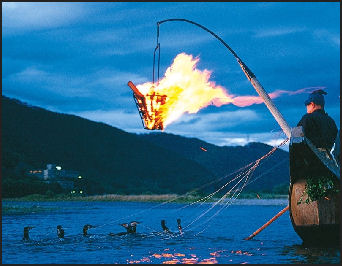
Cormorant fishing is done at night, except after a heavy rain or during a full moon, from May 11th to October 15th on the Nagaragawa River (near Gifu) and the Oze River in Seki and from June through September on the Kiso River (near Inuyama). It also done in Kyoto, Uji, Nagoya and a couple other places.
The practice of cormorant fishing is over 1000 years old. These days it is performed mostly for the benefit of tourists. The ritual begins when a fire is set or a light is turned on over the water. This attracts swarms of trout-like fish called ayu. Tethered cormorants dive into the water and frantically swim around, gulping down fish.
Metal rings and placed around the bird's neck to keep them from swallowing the fish. When cormorants' gullets are full they are hauled aboard the boat, and the still-moving ayu are disgorged on to the deck. The birds are then given rewards of fish, and thrown back in the river to repeat the process.
The boats are manned by four man teams: a master at the bow, in traditional ceremonial headdress, who manages 12 birds, two assistants, who manage two birds each, and a forth man, who takes care of five decoys. To get close to the action you need to take a viewing excursion on a tourist boats, often illuminated with paper lanterns.
Fishermen wear black so the birds can’t see them, cover their heads for protection against sparks and wear a straw skirt to repel water. Pinewood is burned because it burns even on rainy days. On fishing days the cormorants are not fed all day so they are hungry at fishing time. The birds are all caught in the wild and trained. Some can catch 60 fish an hour. After the fishing, the fish are squeezed out of the necks of the birds. Many visitors find this cruel but the fishermen point out that captive birds live to be between 15 and 20 while those that live in the would rarely live beyond five.
See Royal Family
Websites and Resources
Good Websites and Sources: Crested Ibises : Bird Life International birdlife.org/datazone ; Cormorant fishing Wikipedia article Wikipedia ; Cormorant fishing in Yangshuo yangshuo-travel-guide ; Photos of Cormorant fishing molon.de ; Articles on Cormorant Fishing highbeam.com ;
Links in this Website: ANIMALS AND ENDANGERED ANIMALS IN JAPAN Factsanddetails.com/Japan ; ALIEN ANIMALS IN JAPAN Factsanddetails.com/Japan ; BEARS, DEER, SEROW AND WILD BOARS IN JAPAN Factsanddetails.com/Japan ; TANUKIS, FLYING SQUIRRELS, SMALL MAMMALS IN JAPAN Factsanddetails.com/Japan ; SNOW MONKEYS (JAPANESE MACAQUES) Factsanddetails.com/Japan ; EAGLES, SWANS, CROWS AND BIRDS IN JAPAN Factsanddetails.com/Japan ; JAPANESE CRANES Factsanddetails.com/Japan ; IBISES AND CORMORANTS IN JAPAN Factsanddetails.com/Japan ; SNAKES, FROGS, LIZARDS AND TURTLES IN JAPAN Factsanddetails.com/Japan ; BEETLES, LAND CRABS AND INSECTS IN JAPAN Factsanddetails.com/Japan ; PLANTS AND FORESTS IN JAPAN Factsanddetails.com/Japan ; GIANT SQUIDS, SHARKS , THE SEA AND JAPAN Factsanddetails.com/Japan ; WHALES, WHALING AND DOLPHIN HUNTS IN JAPAN Factsanddetails.com/Japan ; PETS IN JAPAN Factsanddetails.com/Japan ; EXOTIC PETS, BIRD FIGHTS AND BEETLES IN JAPAN Factsanddetails.com/Japan ; DOGS IN JAPAN Factsanddetails.com/Japan ; DOG BREEDS IN JAPAN Factsanddetails.com/Japan
Good Sites on Wild Animals: Animal Info animalinfo.org/country/japan ;Japan Animals Blog /japan-animals.blogspot.com ; Hub Pages on Wild Animals in Japan hubpages.com/hub/japanfacts ; ARKive (do a Search for Japan or the Animal Species You Want) arkive.org Animal Picture Archives (do a Search for the Animal Species You Want) animalpicturesarchive
Bird Guidebooks “Guide to the Birds of China” by John MacKinnon (Oxford University Press), “A field Guide to the Birds of Russia and Adjacent Territories” by V.E. Flint (Princeton University Press)and a “Birdwatchers's Guide to Japan” by Mark Brazil (Kodansha). Birding Websites: Wild Bird Society of Japan (Japanese-only website): wbsj.org ; Birds of Japan Gallery by Monte Taylor Birds of Japan ; Birding Hotspots JapanBirding Hotspots Birdwatching in Japan Birding Pal ; Kantori Lode Kantori Lode ; Marimo marimo.or .
Cormorants
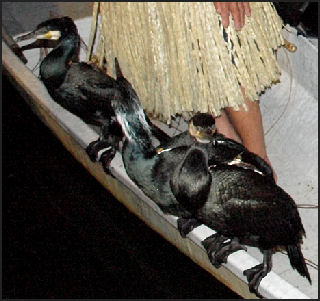
Cormorants are waterbirds, whose name means "crows of the sea." A member of the pelican family, they can fly at speeds of 50mph and are particularly adept at swimming underwater, which is why they are such skilled fish catchers. They feed mostly on fish but also feed on crustaceans, frogs, tadpoles and insect larvae. [Source: Natural History, October 1998]
There are 28 different cormorant species. They live mainly in tropical and temperate areas but have been found in polar waters. Some are solely saltwater birds. Some are solely freshwater birds. Some are both. Some nest in trees. Others nest on rock islands or cliff edges. In the wild they form some of the densest colonies of birds known. Their guano is collected and used as fertilizer.
Kevin Short wrote in the Daily Yomiuri, “Cormorants ride much lower in the water than do the ducks. Their bodies are half-submerged, with only their necks and heads sticking prominently out of the water. Every so often one of them disappears beneath the surface, only to pop up again a half minute or so later. [Source: Kevin Short, Daily Yomiuri, December 2011]
Cormorants are highly specialized to a feeding style that ornithologists call underwater pursuit. When they disappear beneath the surface, they actively chase after fish. The cormorant bio-design is created specifically for this lifestyle. The dense, heavy-set body minimizes buoyancy, making it easy to dive and swim underwater. Short but powerful legs, situated very near to the tail, are perfect for generating a strong forward thrust. Wide webbed feet also enhance the swim kick, and the long neck and long, hooked bill enable the birds to reach out and snare a fleeing fish.
As is always the case in the natural world, the cormorants' specialized underwater adaptations come with some severe trade-offs in other areas. Their legs, for example, are situated so far to the rear that they have great trouble walking around on land. Cormorants thus tend to spend most of their out-of-water time perched on rocks, pilings or tree branches. Also, their heavy bodies make liftoff difficult, and the big birds must taxi across the surface of the lake like a jumbo jet, building up speed before taking off.
When they are not in the water cormorants often rest on tree branches or other objects, sometimes resting with their wings spread full out. In order to further decrease buoyancy and facilitate underwater swimming, cormorant feathers are designed to absorb water. Every so often, however, the feathers become too heavy and waterlogged, and the birds must come out and dry them in the sun and air.
Cormorants form same sex partnerships when they can not find opposite sex partners.
Cormorant Swimming and Fish Catching Ability
Unlike most water birds, which have water resistant feathers, cormorants have feathers that are designed to get throughly wet Their feathers don't trap air like water resistant varieties. This make it easier for them to dive and stay submerged while they chase fish. But this also means that their feathers become waterlogged. After spending time in the water cormorants spend considerable time on shore drying out. When they are out of the water they stretch out their wings to dry their feathers and look a little like wet dogs.
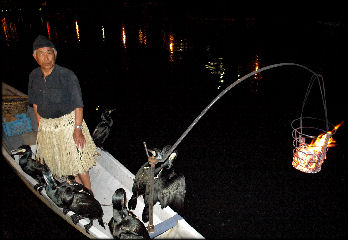 Cormorants can dive as deep as 80 feet and stay underwater for more than a minute. They have oil interwoven in their feathers that make them less buoyant than other birds and they swallow stones, which are lodged in their gut and act like a scuba diver's weight belt.
Cormorants can dive as deep as 80 feet and stay underwater for more than a minute. They have oil interwoven in their feathers that make them less buoyant than other birds and they swallow stones, which are lodged in their gut and act like a scuba diver's weight belt.
Cormorant pursue fish underwater with their eyes open, their wings pressed against their bodies, kicking furiously with their legs and feet at the back end of their bodies. Richard Conniff wrote in Smithsonian magazine: "It swims underwater with its wings folded along its slender body, its long sinuous neck curving inquisitively from side to side, and its large eyes alert behind clear inner lids...Simultaneous thrusts of its webbed feet provide enough propulsion for a cormorant to tailgate a fish and catch it crosswise on its hooked bill...The cormorant generally brings a fish to surface after 10 to 20 seconds and flips it in the air to position it correctly and smooth down its spines.”
Cormorants swallow fish whole and head first. They usually take a little time to shift the fish around to get it to go down their throat the right way. Bones and other indigestible parts are regurgitated in a nasty goo. In the Brazilian Amazon, cormorants have been observed working as a team, splashing the water with their wings and driving fish into shallow water near the shore where they are easily collected.
Cormorant Fishing
Described by Marco Polo and popularized in the children's story Ping, cormorant fishing is still practiced today in some parts of southern China and Japan, where it first evolved. The best time to view cormorant fishing is on a moonless night when the fish are attracted to lights or fires on the boats.
The cormorants go through a routine of diving, catching fish, surfacing and having the fish taken out of their mouth by the fishermen. A piece of string or twine, a metal ring, a grass string, or a hemp or leather collar is placed around their necks to prevent them from swallowing their fish. The birds often have their wings clipped so they don’t fly away and have a looped strings attached to legs that allow them to be retrieved with a pole by the fisherman.
Cormorant fishing boats can carry anywhere from one to 30 birds. On a good day a team of four cormorants can catch about 40 pounds of fish, which are often sold by the fisherman’s wife at the local market. The birds are usually given some fish from the day's catch after the day of fishing is over.
Fishing Cormorants
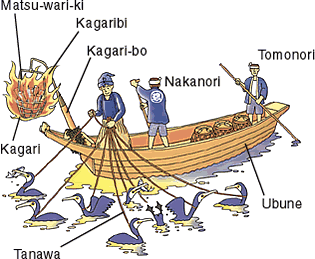
Chinese fisherman use great cormorants (Phalacrocorax carbo) bred and raised in captivity. Japanese fisherman prefer Temmenick's cormorants (Phalacrocorax capillatus), which are caught in the wild on the southern shore of Honshu using decoys and stick that bind instantly to the birds’ legs.
Fishing cormorants usually catch small fish but they can gang up and catch larger fish. Groups of 20 or 30 birds have been observed catching carp that weigh more than 59 pounds. Some birds are taught to catch specific prey such as yellow eel, Japanese eel and even turtles.
Cormorants can live to the age of 25. Some birds get injured and catch infections or die of hypothermia. The disease that Chinese fishermen fear the worst is referred to as the plague. The birds usually lose their appetite, get very sick and there is nothing anyone can do. Some fishermen pray at temples; other seek the help of shaman. In some places dying birds are euthanized with 60-proof alcohol and buried in a wooden box.
Early Descriptions of Cormorant Fishing
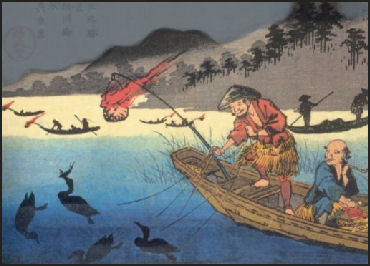
by Eisen The earliest known reference to cormorant fishing comes from a Sui Dynasty (A.D. 581-618) chronicle. It read: "In Japan they suspend small rings from the necks of cormorants, and have them dive into the water to catch fish. In one day they can catch over a hundred." The first referenced in China was written by historian Tao Go (A.D. 902-970).
In 1321, Friar Oderic, a Franciscan monk who walked to China from Italy wearing a hair shirt and no shoes, gave the detailed account by a Westerner of cormorant fishing: "He led me to a bridge, carrying in his arms with him certain dive-droppers or water-fowls [cormorants], bound to perches and about every one of their necks he tied a thread, lest they should eat the fish as fast as they took them,” Oderic wrote. "He loosened the dive-droppers from the pole, which presently went into the water, and within less than the space of one hour, caught as many fish as filled three baskets; which being full, my host untied the threads from about their necks, and entering the second time into the river they fed themselves with fish, and being satisfied, they returned and allowed themselves to be bound to their perches, as they were before."
Describing cormorant fishing by a man named Hunag in the Guilin area, an AP reporter wrote in 2001: at the front of a bamboo raft, "his four cackling cormorants huddle together, preening feathers with long beaks or stretching wings. When he finds a promising spot Hun sets a net around the raft, about 30 feet out to hem fish in...Hung jumps and down a few times on the raft to break the bird's reverie. They snap to attention and jump into the water."
"Huang barks a command and the birds dive like arrows; they paddle furiously underwater chasing fish. Occasionally, fish jump up from the water, sometimes right over the raft, in their effort to escape....A minute or two elapses before cormorants's pointy heads and sleek necks bob up above the water. Some clutch fish. Some catch nothing. Hung plucks them from the water and onto his raft with his boat pole."
Great Cormorants
Kevin Short wrote in the Daily Yomiuri, “Great cormorants(Phalacrocorax carbo) enjoy a cosmopolitan distribution, found across the Eurasian continent as well as Australia, Africa and the eastern coast of North America. Ornithologists divide the species into a half dozen or so subspecies, one of which (P.c. hanedae) is an East Asian form distributed from the Japanese islands south to Taiwan and on the southern part of the Korean Peninsula. [Source: Kevin Short, Daily Yomiuri, December 2011]
“Most species of cormorant are birds of the open ocean coast, but the great cormorant is a bit of a sissy, shunning heavy waves and swells and preferring to live in well-sheltered bays and coves, as well as on inland lakes and marshes. The Japanese name kawau means "river cormorant," and is used in contrast to Temmincks cormorant (P. filamentosus), which inhabits open coasts, and is called umiu, or "ocean cormorant.”
“Although most people assume that the kawau is used in traditional cormorant fishing, it is the umiu instead. Cormorant fishing (ukai), in which birds tethered to lines are used to catch ayu sweetfish, is usually accomplished in areas of fast current; to which the umiu, accustomed to swimming in rough water, is better suited.
“Like many birds that eat an exclusive fish diet, the great cormorants were once driven to the very brink of extinction. During the 1960s, both inland and coastal waters were heavily polluted by powerful insecticides and unregulated factory runoff containing dioxins and other poisons. These chemicals entered the food chain through algae and invertebrates, and were concentrated in the fish. Birds that ate the fish wound up receiving even heavier doses, leading in many cases to reproductive failure.
“Populations of great cormorants in Japan bottomed out in the early 1970s. All that remained were three colonies containing a few thousand birds. Since then, however, restrictions on hunting and vast improvements in water quality have allowed the cormorants to make an amazing comeback. Current estimates place their number at over 50,000. In some areas, such as Lake Biwa in Shiga Prefecture, the cormorants have recovered so well they now threaten the livelihoods of inland water fishermen. During the day, there are usually only a dozen or so cormorants on the lake. Come late afternoon, however, flocks of several dozen each begin arriving in tight V-formation, always from the northeast.
Crested Ibises
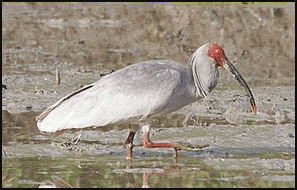
Standing about 75 centimeters tall. the crested ibis (“toki”) is a beautiful bird with white feathers, a red face and a black downward curving bill. Indigenous to Japan, Korea, eastern China and eastern Russia, they are a wading bird that makes their home in rice paddies and marshes. Designated one of the nation's special natural treasures. They were common around the country in the Edo period (1603-1867). However, the number of the birds dramatically decreased because of overhunting, environmental problems and other reasons.
At the beginning of the 20th century crested ibises were found in China, Japan, Korea, Taiwan and the Russian Far East. About 1,400 crested ibises live in China today, up from seven in 1981.
The crested ibis is stockier and has shorter legs than the egrets and herons commonly seen in Japan. In the autumn and winter their plumage turns a pinkish-peach "ibis color." They feed on a large variety of mud-dwelling creatures, particularly loaches. When crested ibises are ready to mate they secret a black substance which they rub on their feathers. In January 2010, birds with the gray feathers produced by the process were observed among the released birds.
Ibises are closely related to spoonbills They have relatively short legs and a sickle-shaped, downward-curving bill that allows them to probe in the mud for mud-dwelling creatures such as loach and snails. Sensitive cells near the tip of the bill enable them to locate prey throughout vibrations and feel. Ibises spend much of their time in wetlands and nest there. They often move from place to place in large colonies. There are 26 species of ibis. Many species are endangered or critically endangered. Ibises are featured prominently in Egyptian mythology.
Endangered Crested Ibis in Japan
The crested ibis was protected during the Edo period. Beginning in the Meiji period in 1868 the protective measures were abandoned and the birds were hunted for their beautiful feathers as well as their meat, which was thought to have special medicinal and nutritional value.
Over the years crested ibises have been killed as agricultural pests and sickened and killed by pesticides and fertilizers. Deforestation disrupted their nesting sites. By the 1930s, only small populations survived around the Sea of Japan in central Honshu. Sado Island, an island in the Japan Sea about 25 miles offshore from central Honshu, was the home the of the last wild populations. The last natural breeding was confirmed in 1976 on Sado Island. In 1981, only five crested ibises remained in Japan and naturalists decided to capture them and try to breed them artificially. The last pure-bred Japanese crested ibis died at the age of 36 in October 2003.
Artificial breeding didn't work. Crested ibises had also disappeared from China, Korea and Russia and looked as if the bird was doomed to extinction.
Return of the Crested Ibis to Japan
Just when all hope was about lost, a population of wild crested ibises was found in Shanxi province central China. The Chinese government immediately set up program to protect and artificially breed the birds. The program was a success. By 2000 there were 150 wild birds and 200 ones artificially-bred from seven original birds.
In 1999, China began loaning pairs of crested ibises to Japan. Sado Crested Ibis Conservation Center was established on Sado Island. In May 1999, an egg produced by crested ibis given to Japan by China hatched at the Sado Conservation Center. It was the first time a crested ibis had been hatched in Japan since they disappeared. The event received a lot of media attention. Afterwards more chicks were born.
Breeding is being carried by coupling male and female descendants of Yu Yo — the first descendant of a the Chinese pair brought to Japan. One problem with the system is inbreeding. To address this problem birds are being brought in from the outside. But this plan has disrupted by a ban on importing birds because of worries about bird flu.
As of July 2007, about 107 Japanese crested ibises had been bred from Chinese-born crested ibises.
Japan is also working with the Chinese to protect crested ibises in China, with a major project being carried near Xian in Yangxian district that encourages farmers in area where the birds live to stop using chemical fertilizers and pesticides.
Release of Crested Ibis Into the Wild
At Sado Chinese-born Japanese crested ibises are bred with the goal of releasing them in the wild. Japan started artificial breeding of crested ibises born in China in 1999, and since then the number of crested ibises kept by Japan has been steadily increasing. Hoping for the birds to breed naturally, the ministry began releasing ibises on the island in 2008. A total of 78 birds have been released into the wild in five batches as 0f 2012. Five pairs laid eggs in 2010, and seven pairs in 2011. However, some eggs fell out of nests and others were not fertilized. Therefore, no chicks were hatched from the eggs.
In September 2008, 10 crested ibises were released into the wild on Sado Island with a team of government officials and volunteers keeping an eye on them. It was the first time the birds had flown freely in the wild since 1981. A week after the were released, eight were confirmed to be healthy and good condition. Six of the birds were outfit with transmitters and GPS devices, so their locations could be determined. They were spotted in various locations including rice paddies, where they were seen looking for food. There were some worries about the ibises scattering to different locations on the island. Ibises usually stick together in groups.
Ibises prepared for release in the wild on Sado island are trained inside a 80-meter-long, 15-meter-high, and 50-meter wide cages that has rice paddies ponds and other natural features like those on Sado Island. The birds are taught to eat loaches and Japanese bitterlings released into ponds for them and fly to avoid enemies such as cats and hawks. The program was modeled afer the one used to raise storks in Hyogo Prefecture.
The aim of the facility is to create an environment close to the natural environment of ibises. The key to returning ibises to the wild is to encourage their natural instincts such as catching their own food and nesting. To provide enough food for the birds, farmers on Sado Island have been given subsidies to flood fields so loaches and other creatures that the ibises feed on can grow.
A year after 10 were released in 2008 the whereabouts of only seven was known. The released ibis failed to pair off and mate.The four males remained on Sado. The three females flew to Honshu. One male was observed making a nest for himself without a female companion. A female crested ibis was found dead on Sado in December 2008. It was thought to have been injured and then attacked by a tanuki. (racoon dog).
In September 2009, a second batch of ibises was released on Sado Island. Nineteen birds were released en masse to try to get them to form a flock. A month later seven of them formed a nine-bird flock with two others from the first batch released in 2008.
In October 2010, 14 more ibises — eight males and six females as old as five years old — were released into the wild during the third release of the birds. This time the birds flew directly out of the 4,000-square-meter acclimation cage.
Crested Ibis Problems
Of the 30 ibises released as of 2009,only two did not learn how or fly. After the release one flew straight into a bush and another went missing.
In April 2010, eggs were found in the nest of a crested ibis in Sado island. It was the first time in 31 years that eggs had been laid by the species in Japan. The eggs were laid by a one-year-old female that mated in the wild with a three-year-old male. In the end the ibises threw all three of the eggs out of the nest. If a chick would have hatched it would have been the first wild hatch of ibises in Japan in 34 years. A second nesting resulting from mating between a 1-year-old female and 4-year-old male also failed to produce a hatching. In that case the nest was invaded by two crows while the ibises were away and the crows damaged the eggs.
In March 2010, a marten entered a bird cage on Sado Island containing 11 ibises being prepared for release into the wild and killed nine of the birds. A marten is small weasel-like animal. It entered the cage through a small hole and climbed a tree and killed the birds. Only of the birds was eaten. The others are believed to have been killed for the fun of it of it. On eof the birds that escaped had received training to escape from small predators. Video images from a security camera showed the marten entering the cage and scampering around. But no one was watching the video when the attack occurred. There are still more than 100 ibises living in captivity. The $14 million cage were the tragedy happened is 15 meters tall and covers 4,000 square meters. It encloses rice terraces, ponds and trees and was intended to duplicate the landscape the birds — will be released into in the wild.
Pesky Birds in Japan
Thousands of crows, cormorants and even owls have descended on Tokyo and other Japanese cities, eating garbage and tormenting residents.
Kites are a type of hawk with a wingspan of up to one meter. In Kamakura, Kanagawa they have attacked people and snatched food from outdoor markets. Their problems is they have become too bold and accustomed to people who like to throw food in the air and watch them catch it.
The 11,000 cormorants that have made their home in a former imperial park produce so much white dropping it shows up on aerial photography.
There are lots of pigeons. In some places they take the subway to get from one place to the next. In Fukuoka they make their way through a tunnel.
Crows in Japan
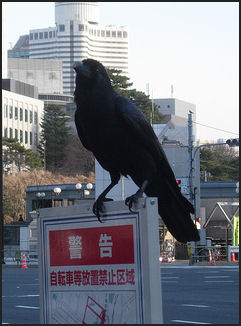
Crows are the most widely seen bird in Japan. The largest and most destructive ones are jungle crows, which have three foot wing spans and migrated to Japan from Southeast Asia, displacing the smaller local carrion crows. The Japanese have traditionally regarded crows as bearers of ill fortune. According to one superstition "Three crow cries, and someone has died," Another goes: "See a crow and take three steps back." Even so a three-legged crow is the symbol of Japan's national soccer team and was a major player in Japan's creation myth. See Creation Myth, Religion
The number of crows in Tokyo rose from around 7,000 in 1985 to about 37,000 in 2002. By some estimates there are 110,000 crows in the greater Tokyo area.. They are fearless of humans and raptors and have no natural enemies. On average they live to be 19 years old. Their numbers are increasing.
Crows can be found in a wide variety of habitats: any place where there are trees, buildings or cliff to make a nest on, They use whatever materials are available to make nests, even wires and garbage. Birds in cities tend to jungle crows while those in rural areas are more likely to be carrion crows. Crows are omnivorous and will eat almost anything: carrion, insects, other birds’s eggs and garbage,.
Jungle Crows and Carrion Crows
The jungle crow and carrion crow are the two species of crow commonly seen in Japan. Jungle crows have large bodies, powerful feet and strong sharp beaks. They are natural scavengers and prefer to nest in trees. They travel in groups called mobs that are notorious for their noise and brazenness. In Japan, the crows are well-adapted to urban life. They build their nests oi park trees, utility poles and power lines. They drink water from fountains and feed on everything from dried fruit to vomit. Carrion crows are difficult to tell from jungle crows but produce a harsher “kaww” and bob their heads when they make the sound while jungle crows produce a clearer call and bob their head and tail when they make the noise.
Kevin Short wrote in the Daily Yomiuri, “These two species can be told apart by the thickness of their bill. In fact, the common Japanese names, hashi-buto-garasu for the jungle crow and hashi-boso-garasu for the carrion crow, respectively mean “thick-billed crow” and “thin-billed crow.” Also, the jungle crow is slightly larger and heavier built, and sports a high protruding forehead. [Source: Kevin Short, Daily Yomiuri, June 17, 2010]
“Ecologically, the jungle crow prefers dense forests and coastlines; while the carrion likes meadows and open farmland. The rocky coasts and heavily forested mountains of the Kii Peninsula would have provided ideal jungle crow habitat, but the extensive rice paddies of the Nara Basin would have favored carrion crows.” Which species is the crow in Japanese mythology. “The shape of the bill and forehead on the traditional images are inconclusive, but the current emblem used by the national soccer team is clearly that of a jungle crow.”
“The jungle crow’s thick, sharply-hooked bill rivals that of an eagle. Such a powerful bill is ideal for ripping open a fish or deer carcass. Ironically, it is also perfect for slicing open a plastic garbage bag. As a result, jungle crows have proliferated in urban areas. Intelligent and adaptive, they also prey heavily on urban birds such as doves, pigeons, starlings and sparrows. I have seen these fearsome hunters swallow an unfortunate sparrow fledgling in a single gulp.”
“During the spring and summer nesting season, each mated pair establishes and defends their own feeding territory. Jungle crows are famous for stealing metal clothes hangers from backyards and verandahs to weave into their huge nests. They seem to have a special fetish for blue items. The parents aggressively defend their nest and brood, and in some urban parks and gardens even dive-bomb people that stray too close.”
“In the southern Kanto Region, jungle crows have taken over the urban and suburban residential areas, but carrion crows still thrive in the open countryside. Here they enjoy a varied natural diet, including frogs, lizards, snakes, crayfish, loaches, stream crabs, grasshoppers and beetles, as well as numerous sweet fruits and berries.”
Smart Crows in Japan
Crows have large forebrains and regarded as among the smartest birds. There brain to body ratio is bdouble that of horses, pigs and cats.
In Sendai, carrion crows harvest walnuts and have developed and ingenious way to break open their shell. They drop nuts off of tree branches onto roads and wait for cars to run over them and collect the nuts. They even wait for Walk signs at crosswalks to collect the nuts.
have also been observed making note of where other birds are building their nest so they can steal the eggs later. They are one of the few known tool-making animals: having been observed fashioning tools out of sticks and pieces of wire to extract insects from inside of trees.
Crows as Pests in Japan
Crows are terrible nuisances. They rip open garbage bags and spread garbage everywhere, startle motorists, rip open laundry bags, stare down dogs, and scare children. They nest on power lines, disrupt commuter trains, pluck laundry from off clotheslines, produce loud squawking noises and bombard pedestrians with the gooey droppings.
Crows had been videotaped in the Kanagawa prefecture near Tokyo picking up pieces of gravel and placing them on busy rail lines. Nests in power lines have caused short circuits that led to about 50 or 60 power blackouts each year. There have been reports of crows carrying off kittens. At the Ueno zoo in Tokyo there were reports of them carrying off prairie dogs and pecking holes in the backs of deer.
In April 2001, Ananova reported: “Tokyo's crow population has exploded to around 30,000, and residents say the birds have started attacking them. There are reports of people falling off their bicycles as aggressive crows fly at them. Local government officials are trying to curb the numbers by removing eggs or newborn birds from nests. The Wild Bird Society of Japan says the population has increased by around 10,000 in the last three years. Johoku Park's management office has been inundated with complaints from people living nearby who say the crows attack them while they walk their dogs. Park guard Tsuneo Yamazaki told the Daily Yomiuri: "Even if you try to scare the birds away, they are not afraid of humans at all. In fact, they will turn against you. "There are people who fell off their bicycles while being chased by crows. We really would like to do something about it." [Source: Ananova, April 18, 2001]
Crows are particularly aggressive in the spring nesting season when they defend their territories from perceived intruders. At that time of the year there are hundreds of reports of crows swooping down and attacking from behind, kicking and pecking their victims head. Occasionally they draw blood.
Crows have pilfered cypress bark from the roof of temples in Japan and carried it into the mountains to make their nests, producing leaks which have damaged valuable Buddha statues.
Crows and People in Japan
Crows have largely lost their fear of humans. Attempts to shoo them away are often futile. The crow simply hop a couples steps out of harms way. Mothers are so fearful of crows they clear their children out parks when mobs of crows show up. People have been hurt falling while pursued by crows and even seriously hurt after being struck by a vehicle while fleeing.
An exterminator who takes down about 250 crow nests a month in the spring told the Washington Post, "People are scared by these crows. They are big, black, with big beak, and kind of scary." One 38-year-old housewife told AP, "When I see a crow, I usually run away."
Describing the battle between crows and humans, one Tokyo sanitation worker said, "It's war between us. It's like oil and water, like sharks and men." The governor of Tokyo said he planned "to make crow meat pies Tokyo's special dish."
Some people have suggested the crow problem is really a people problem. As part of an efforts to get people to recycle their trash some places require people to put their garbage in clear bags. Crows like the clear bags and particularly go after ones that have pink things inside which bring to mind the carrion they naturally feed on.
A number of studies have been conducted on crow behavior. One found that crows prefer food scraps in transparent bags and least of all like scarps in black bags.
Efforts to Control Crows in Japan
In some places blue nets have distributed to residents to place over their garbage cans. Other places people are required to put their trash bags in special enclosures or use special translucent bags and collect their garbage before dawn when the bird are most fond of feeding. In some parks in Tokyo small flags attached to trees warn people of the presence of crows. Each spring workers fan out across the city to take down crow nests.
Power companies have installed umbrella-like devices and put up wires on power lines to keep crows away. They didn't work. Garbage collectors have proposed better ways for people to put out their garbage but people have often ignore the advise. Some even feed the crows.
In Tokyo, Mayor Ishihara launched a $1 million a year “total crow-eradicating” campaign which emphasized using deadly force to deal with the crows. In one campaign the government hoped to kill 7,000 crows by luring them with meat into wood-and wire traps and later exterminating them with carbon dioxide. The 100 traps used cost about $250,000 and had an wire opening that let the birds in but caught their feathers when they tried to get out, preventing them from escaping.
In April 2002, the Tokyo government announced that it had captured 4,210 crows in the previous four months using 100 traps placed in zoos and parks with dog food, mayonnaise and lard as bait. Officials didn’t say what they did with the crows after they were caught. By 2005 the crow population in Tokyo was 17,900, half of what it was in 2001. The goal is to reduce the number to 7,000.
The number of crows caught in traps has been declining as the birds get wise to what the traps. Many feel these efforts were largely futile. Most of the crows that were caught were too young to bred and crows seemed to be as much of pests as they always were.
Runaway Penguin Enjoys Life in Tokyo Bay
In May 2012, A Humboldt penguin that escaped from an aquarium in Edogawa Ward, Tokyo, in March has been repeatedly spotted swimming in Tokyo Bay. Zoological experts believe the penguin does not intend to leave Tokyo Bay, perhaps because it likes the fish in the area.One expert said, "Tokyo Bay is a good habitat for penguins." Humboldt penguins are accustomed to living in relatively warm waters along the Peruvian and Chilean coasts. There are about 1,700 Humboldt penguins in Japan, of which 134 are kept at the Tokyo park, where the runaway escaped. [Source: Yomiuri Shimbun, May 21, 2012]
“At around 8:50 a.m. on May 7, the Tokyo Coast Guard Office received a report that a penguin was swimming in waters near Shiokaze Park. The coast guard office dispatched a patrol vessel and special rescue boat to the area, where the crew spotted a penguin with a yellow identification tag on its right wing.The crew of the special rescue boat approached the penguin, but were unable to catch it. About an hour later, they lost sight of the penguin.On May 8, the penguin was seen off Harumi Pier, about three kilometers away. On May 12, the penguin was spotted near Rainbow Bridge.
“The penguin was born at Tokyo Sea Life Park in January last year. It is a very young bird of unknown sex. However, the bird is about the size of an adult penguin, which measures about 60 centimeters to 70 centimeters long. At the sea life park, the penguin was not given a name and referred to as "337," its ID number. On the evening of March 3, 2012, an official of a bird park saw a penguin swimming near the mouth of Old Edogawa river. The No. 337 penguin was then found to have escaped. Park officials assumed the penguin climbed onto a rock hill in an outdoor exhibition space and escaped through a gap in a double fence.
“Soon after the penguin was discovered missing, it was seen downstream in the Arakawa river. Since then, the penguin has been spotted about 30 times. Although it has gradually migrated westward, it has shown no signs of leaving Tokyo Bay.At the park, penguins have managed to escape on two occasions, but in both cases, were successfully recaptured in nearby bushes. This is the first time that a runaway penguin as reached the sea. Kazuhiro Sakamoto, deputy director of the Tokyo Sea Life Park, said, "The penguin might have developed a behavioral response to search for a new colony." Regarding the reason why the penguin has not yet left Tokyo Bay, Kazuoki Ueda, a researcher at nonprofit organization Penguin Conference Japan, said: "Penguins have a homing instinct. So it may be unable to live far from the park where it was born.”
“Tokyo Bay has plenty of fish favored by penguins, such as young sweetfish and goby, and the waters are calm. Though park officials are brainstorming ways to recapture the penguin, it is a difficult task as Humboldt penguins can stay underwater for nearly five minutes and swim at speeds of 30 kph to 40 kph. Because penguins return to land at around sunset to sleep, officials are hoping to recapture the penguin when it is asleep. However, there are many areas along the coast of Tokyo Bay where a penguin can go unnoticed by humans. The penguin has yet to be spotted on land.
Image Sources: 1) JNTO 2) 3) Ray Kinnane 4) Gifu government 6) Birquest Mark Beamon
Text Sources: New York Times, Washington Post, Los Angeles Times, Daily Yomiuri, Times of London, Japan National Tourist Organization (JNTO), National Geographic, The New Yorker, Time, Newsweek, Reuters, AP, Lonely Planet Guides, Compton’s Encyclopedia and various books and other publications.
Last updated January 2013
